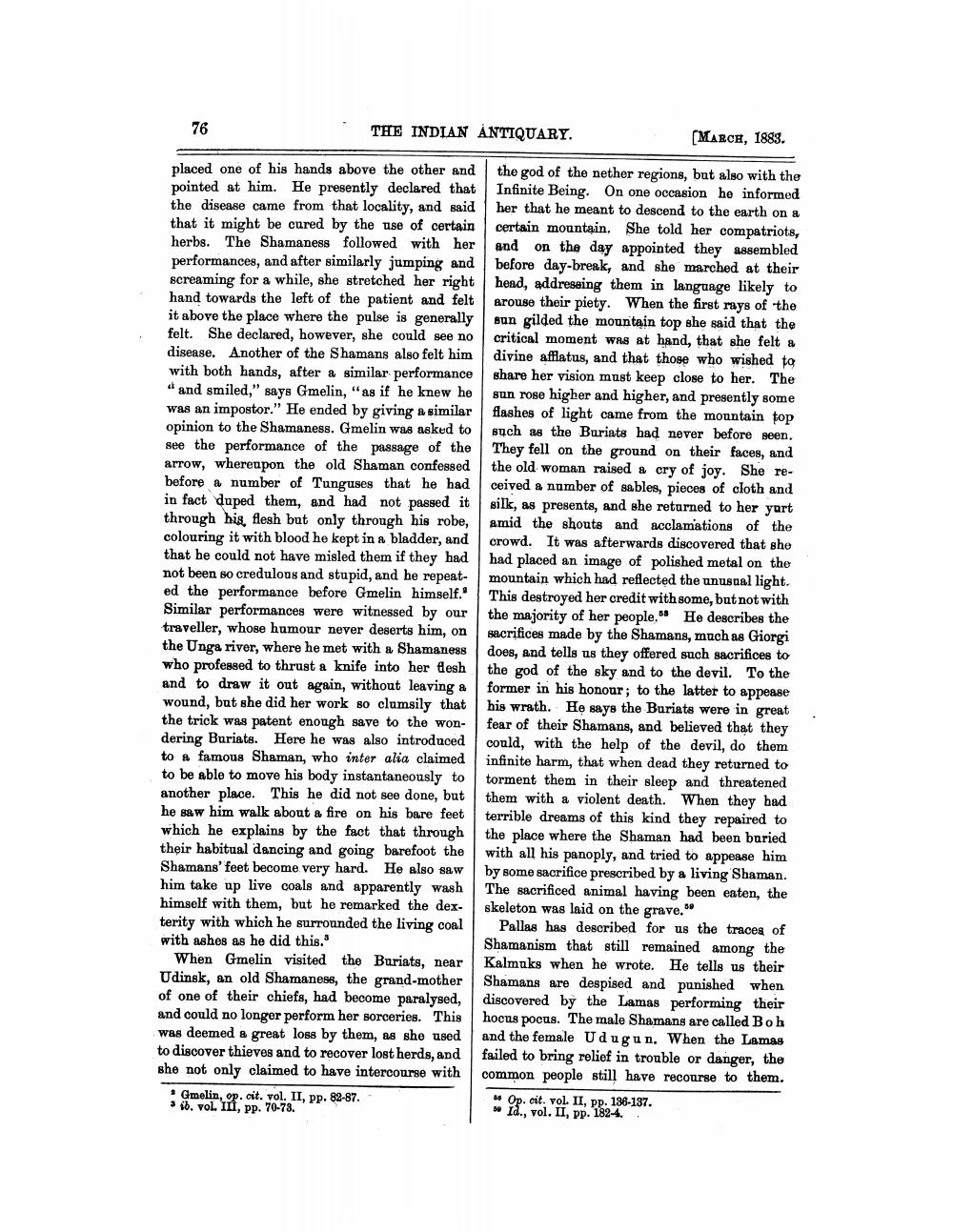________________
76
THE INDIAN ANTIQUARY.
[MARCH, 1883.
placed one of his hands above the other and pointed at him. He presently declared that the disease came from that locality, and said that it might be cured by the use of certain herbs. The Shamaness followed with her performances, and after similarly jumping and screaming for a while, she stretched her right hand towards the left of the patient and felt it above the place where the pulse is generally felt. She declared, however, she could see no disease. Another of the Shamans also felt him with both hands, after a similar performance
and smiled," says Gmelin, "as if he knew he was an impostor." He ended by giving a similar opinion to the Shamaness. Gmelin was asked to see the performance of the passage of the arrow, whereupon the old Shaman confessed before a number of Tunguses that he had in fact duped them, and had not passed it through his, flesh but only through his robe, colouring it with blood he kept in a bladder, and that he could not have misled them if they had not been so credulous and stupid, and he repeated the performance before Gmelin himself." Similar performances were witnessed by our traveller, whose humour never deserts him, on the Unga river, where he met with a Shamaness who professed to thrust a knife into her desh and to draw it out again, without leaving a wound, but she did her work so clumsily that the trick was patent enough save to the won- dering Buriats. Here he was also introduced to a famous Shaman, who inter alia claimed to be able to move his body instantaneously to another place. This he did not see done, but he saw him walk about a fire on his bare feet which he explains by the fact that through their habitual dancing and going barefoot the Shamans' feet become very hard. He also saw him take up live coals and apparently wash himself with them, but he remarked the dex. terity with which he surrounded the living coal with ashes as he did this.
When Gmelin visited the Buriats, near Udinsk, an old Shamaness, the grand-mother of one of their chiefs, had become paralysed, and could no longer perform her sorceries. This was deemed a great loss by them, as she used to discover thieves and to recover lost herds, and she not only claimed to have intercourse with
Gmelin, op. cit. vol. II, pp. 82-87. op. VOL. III, pp. 70-73.
the god of the nether regions, but also with the Infinite Being. On one occasion he informed her that he meant to descend to the earth on a certain mountain. She told her compatriots, and on the day appointed they assembled before day-break, and she marched at their head, addressing them in language likely to arouse their piety. When the first rays of the sun gilded the mountain top she said that the critical moment was at hand, that she felt a divine afflatus, and that those who wished to share her vision must keep close to her. The sun rose higher and higher, and presently some flashes of light came from the mountain top such as the Buriats had never before seen. They fell on the ground on their faces, and the old woman raised a cry of joy. She received a number of sables, pieces of cloth and silk, as presents, and she returned to her yurt amid the shouts and acclamations of the crowd. It was afterwards discovered that she had placed an image of polished metal on the mountain which had reflected the unusual light. This destroyed her credit with some, but not with the majority of her people. He describes the sacrifices made by the Shamans, much as Giorgi does, and tells us they offered such sacrifices to the god of the sky and to the devil. To the former in his honour; to the latter to appease his wrath. He says the Buriats were in great fear of their Shamans, and believed that they could, with the help of the devil, do them infinite harm, that when dead they returned to torment them in their sleep and threatened them with a violent death. When they had terrible dreams of this kind they repaired to the place where the Shaman had been buried with all his panoply, and tried to appease him by some sacrifice prescribed by a living Shaman. The sacrificed animal having been eaten, the skeleton was laid on the grave.
Pallas has described for us the traces of Shamanism that still remained among the Kalmuks when he wrote. He tells us their Shamans are despised and punished when discovered by the Lamas performing their hocus pocus. The male Shamans are called Boh and the female Udugun. When the Lamas failed to bring relief in trouble or danger, the common people still have recourse to them.
Op. cit. vol. II, pp. 136-137. * Id., vol. II, pp. 1824.




